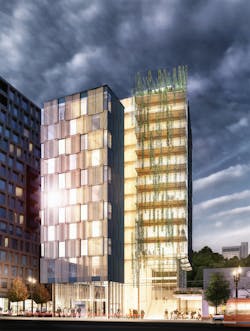Developer Earns $1.5M Grant for Timber Tower Design
The USDA Softwood Lumber Board and Binational Softwood Lumber Council U.S. Tall Wood Building Prize competition is helping uncover and fund the best new technologies relating to mass timber construction. One of the two winning entries, dubbed Framework (right), reflects the ethos of farm-to-frame, a way to create a symbiosis between urban development and the region’s agricultural industry. “Being in a wood building is a great experience,” says Thomas Robin, LEVER Architecture and leader of the winning team. “People love to live and work in wood buildings and if we can find a way to create product that’s sustainable, less impactful and a great experience—especially in places where we have resources at our fingertips—why wouldn’t we?”
Farm-to-frame is applicable in many parts of the country, especially in Portland. Still “mass timber’s not going to replace all building types, it’s going to become another option,” says structural engineer Eric McDonnell from KPFF, part of the winning team for the planned mixed-use timber tower.
One of Framework’s most innovative attributes is its exposed lateral Cross Laminated Timber (CLT). “It’s very panelized,” says McDonnell, “like pre-cast, everything comes down to the connections.” Connections ensure the building’s seismic stability, reinforcing them in a smart way, and can sustain a structure through a 500-year seismic event, says McDonnell, who witnessed innovation in structural engineering while helping to rebuild Christchurch, New Zealand after a large earthquake.
McDonnell became familiar with their techniques and imported his knowledge stateside. The keystone is the deployment of a U-shaped F-plate (UFP). It’s also been applied to precast walls and tested in studies at Stanford, and deployed in Canada. The UFP acts as an electrical fuse to protect the structure from seismic stress, says Robin. Like fuses, UFPs are easily accessible to evaluate for damage, or replace if necessary—although typical seismic activity experienced in the Portland area should not damage the UFPs. The team’s $1.5 million award will fund the project’s necessary research and development to test the process. The likelihood of its success is very high, McDonnell says: “It’s way beyond code.” The building has an anticipated completion date of Dec. 2017.
